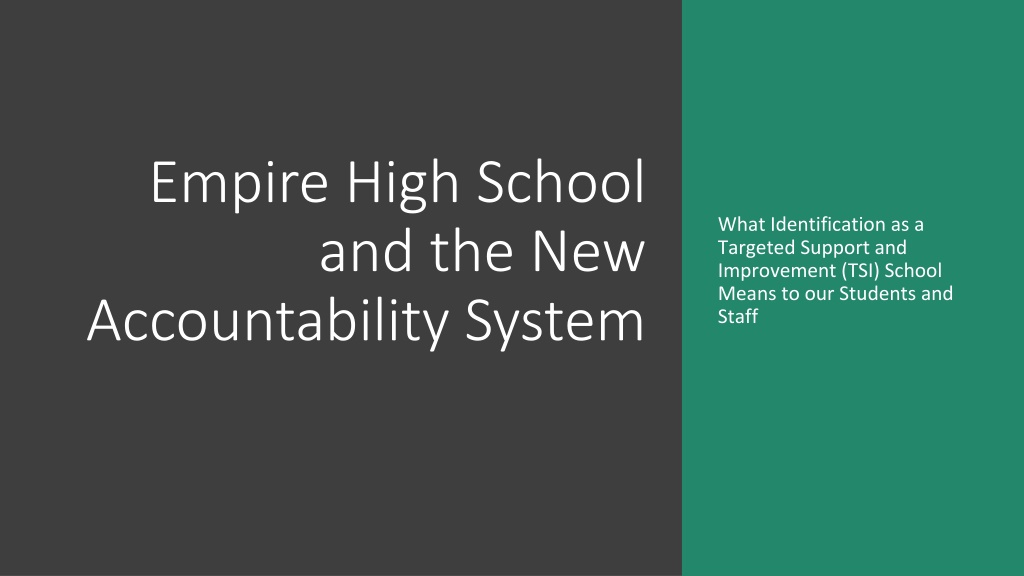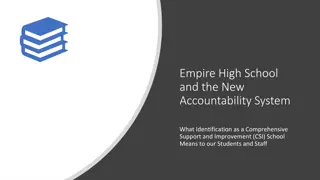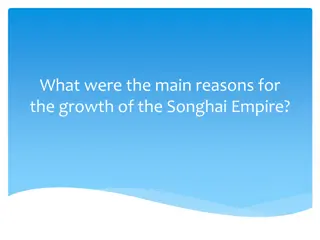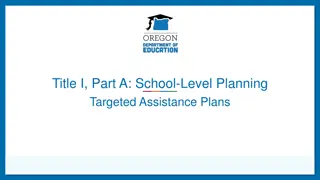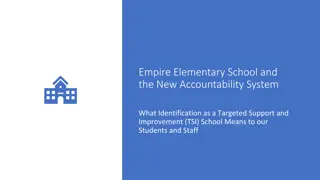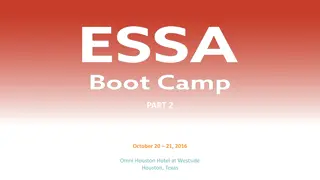Understanding Empire High School's Targeted Support and Improvement Program
Empire High School's engagement with the new accountability system, ESSA funding, and NY's indicators of school performance reflect a commitment to educational equity and student success. The targeted support and improvement efforts aim to enhance school performance and ensure all students thrive, with a focus on various indicators and measures of success.
Uploaded on Oct 07, 2024 | 0 Views
Download Presentation

Please find below an Image/Link to download the presentation.
The content on the website is provided AS IS for your information and personal use only. It may not be sold, licensed, or shared on other websites without obtaining consent from the author. Download presentation by click this link. If you encounter any issues during the download, it is possible that the publisher has removed the file from their server.
E N D
Presentation Transcript
Empire High School and the New Accountability System What Identification as a Targeted Support and Improvement (TSI) School Means to our Students and Staff
Discuss Reasons for a New Accountability System Review New York s New Accountability System Including the new indicators of school performance Present How Our School Performed on Each of the Indicators Discuss Targeted Support and Improvement School How we will build on our current school-improvement efforts Today s Presentation
The Every Student Succeeds Act or ESSA is the federal law for K-12 education in the United States. States receive funding from the United States Department of Education to help districts and schools improve student outcomes, particularly for groups of students who have historically underperformed compared to state averages. NY receives about $1.6 billion annually in ESSA funding. At Empire High School, ESSA funding supports programs and services that include: academic support for students who are struggling; before and after-school tutoring; counseling; mentoring; supplemental supplies for homeless students; and parent and family engagement workshops. In exchange for funding, states must have an accountability system for measuring school performance and determining which schools need extra support. States have flexibility in developing these accountability systems o States can incorporate measures of school success that go beyond test scores Why a New Accountability System? 3
Accountability Educational Equity Educational equity means all students succeed and thrive in school no matter who they are, where they live, or where they go to school. Accountability is everyone s responsibility: we should celebrate what we do well and recognize what we need to improve, and identify the implications of the choices we make. Being identified for Targeted Support & Improvement means we will get extra help to assist us in our improvement efforts. 4
New Yorks New Accountability System The New York State Education Department (NYSED) has established a new set of indicators to measure school performance More than a thousand people parents, educators as well as national experts offered input Broader than in the past Much stronger focus on student growth and progress More comprehensive look at school performance 5
Multiple Measures of Performance NYSED is using several indicators to determine the performance of high schools: Student academic achievement in language arts, math, science, and social studies Academic progress in language arts and math English language proficiency Chronic absenteeism Graduation rates College, career, and civic readiness For every school, these measures are applied to allstudentsand specific student subgroups, such as members of racial and ethnic groups, students with disabilities, and English language learners 6
Specific Student Subgroups There are nine student subgroups for which a school can be identified as TSI: Asian African-American Hispanic Multiracial Native American White English language learners Low-income students Students with disabilities A school needs 30 student results over two years to be held accountable for a specific student subgroup 7
How Schools Are Measured On Each Indicator For every indicator, a school is given a numeric score: 1 is lowest 4 is highest For every indicator: A score of 1 to 4 is given for all students at a school and A score of 1 to 4 is given for each specific student subgroup at a school for which the school is accountable 8
Schools That Can be Identified As TSI In addition to performance on the individual indicators for each student subgroup, to be identified as TSI a school must: Have been in Priority or Focus status during the 2017-2018 School Year The earliest a school that was in Good Standing in the 2017-2018 School Year can be identified as TSI is if a subgroup meets criteria for 2017-2018 and 2018-2019 School Years In the 2017-18 school year, Empire High School was a Focus School and therefore is eligible for TSI status. Empire High School was identified as TSI for the performance of the X subgroup. This presentation will explain why Empire High School was identified for this subgroup, and the support we will receive to make improvement. 9
The Individual Indicators What each indicator measures and how our school performed 10
Measuring Student Academic Achievement (Composite Performance Index) This indicator measures achievement on state assessments in English language arts (ELA), math, science, and social studies. Levels are assigned based on where a school ranks compared to all other schools in the state: Rank Level 10% or Less 1 10.1 to 50% 2 50.1 to 75% 3 Greater than 75% 4 Schools receive credit based on a student s best results on high school assessments within 4 years of a student entering grade 9. This year we were held accountable for students who entered grade 9 in the 2014-15 school year. Schools receive no credit for students who score at accountability Level 1, partial credit for students who score at accountability Level 2, full credit for students who score at accountability Level 3, and extra credit for students who score at accountability Level 4. The next slide shows how scores from 0 100 on Regents exams are converted to Levels. A school can receive an index that ranges from 0 to 250. Empire High School s [x] subgroup had a Performance Index of X out of a possible 250. Empire High School received a Level 2 on this indicator, meaning our school performed between the 10th and 50th percentile among all elementary and middle schools in the state. 11
13 This indicator measures overall student progress on state assessments in English language arts and math, compared to our school s measures of interim progress (MIP), the State MIP and long-term goals In ELA, Empire High School s [x group] had a school MIP of X, the State MIP was X, and the State long-term goal was X. For the [x group], Empire High School s performance was X. Since we did not meet either MIP for this subgroup, we received Level 1 in ELA. In math, Empire High School had a school MIP of X for the [x group], the State MIP was X and the State long-term goal was X. Since we met our school MIP for this subgroup, we received Level 2 in math. However, because x group did not receive a Level 2 for both ELA and math our overall Level for Academic Progress for x subgroup was Level 1. Measuring Academic Progress
14 This indicator measures progress of English language learners (ELL) in meeting their individual targets on the New York State English as a Second Language Achievement Test (NYSESLAT). Each subgroup for which a school is accountable receives a Success Ratio on this measure based on the percent of students who made progress compared to the probability that a student will make progress. A success ratio of 1.0 means students did exactly as expected in terms of making progress towards English proficiency; greater than 1.0 better than expected; and less than 1.0 less than expected. On this indicator, for X subgroup, Empire High School had a success ratio of X and received a Level 2. Measuring English Language Proficiency
15 This indicator measures the percentage of students who miss 10% or more of the days they are supposed to attend, compared to our school s measures of interim progress (MIP) and long-term goals. Empire High School s x subgroup had a school MIP of X%, the State MIP was X%, and the State long-term goal is X%. Empire High School s performance for X subgroup was X%, meaning X% of these students were absent for 10% or more days of instruction. Since x subgroup met the school MIP, but not the State MIP or long-term goal for student subgroups, x subgroup received a Level 2. Measuring Chronic Absenteeism
16 This indicator measures the rate of graduation for individual cohort of students who first entered grade 9 4, 5, and 6 years ago, compared to x subgroup s measures of interim progress (MIP), the State MIP and long-term goals. For the 4 year cohort X subgroup had a school MIP of [enter content for MIP], the State MIP is [enter content for State MIP], and the State long-term goal is [enter content]. For the 5 year cohort X subgroup had a school MIP of [enter content for MIP], the State MIP is [enter content for State MIP], and the State long-term goal is [enter content]. For the 6 year cohort X subgroup had a school MIP of [enter content for MIP], the State MIP is [enter content for State MIP], and the State long-term goal is [enter content]. For this subgroup, we received a Level X for the 4-year cohort, a Level X for the 5-year cohort, and a Level X for the 6-year cohort, resulting in an overall Level for graduation rate of Level 1. Measuring Graduation Rates
17 This measure combines the Student Achievement and Graduation Rate indicators Creates a Combined Composite Performance and Graduation Rate measure by: Adding the Composite Performance Level and the Graduation Rate Level, giving a number from 2-8. For x subgroup that would be a Composite Performance Level of 2 and a Graduation Rate Level of 1, equaling 3, for x subgroup. Ranking schools with the same number (for Empire High School a 3) for the subgroup based on their rank for Composite Performance and for Graduation Rate. Assigning a percentile rank to the result. Measuring Student Test Achievement (Composite Performance) & Graduation Rates Combined On this indicator, our school received a score of 1 for X subgroup, placing the school among the lowest ten percent in the state.
18 This indicator measures the percentage of students who achieve various type of diplomas and credentials and the degree to which students enroll and succeed in advanced courses or career and technical education programs. Empire High School s x subgroup had a school MIP of [enter content for MIP], the State MIP is [enter content for State MIP], and the State long-term goal is [enter content]. [Enter content for Empire High School level] Measuring College, Career, and Civic Readiness
Identification for Targeted Support and Improvement A high school can be identified for Targeted Support and Improvement, if its Levels of Performance meets one of these five scenarios for specific student subgroups Composite Performance Combined Composite Performance & Grad Rate Chronic Absenteeism Grad Rate ELP Progress CCCR Both Level 1 Level 1 Any Level Any Level Either Level 1 Level 1 None Any One of the Three is Level 1 Either Level 1 Level 1 Level 1 Any Level Either Level 1 Level 1 Level 2 Any One of the Three is Level 1 Either Level 1 Level 1 Level 3 or 4 Any Two Level 1 For X Subgroup, Empire High School s Performance was: Composite Composite Performance Performance Combined Composite Performance Combined Composite Performance & Grad Rate & Grad Rate Chronic Chronic Absenteeism Absenteeism Grad Rate Grad Rate ELP ELP Progress Progress CCCR CCCR 2 1 1 2 1 2 1 Empire High School has been identified for Targeted Support and Improvement because we met Scenario 4 for [X subgroup]. Empire High School has been identified for Targeted Support and Improvement because we met Scenario 4 for [X subgroup]. 19
Targeted Support & Improvement What it means to our school 20
Required TSI School Interventions All Targeted Support & Improvement Schools are required to: TSI Schools will be required to develop a School Comprehensive Education Plan based on the results of an on-site needs assessment and other data collected by the district. TSI TSI This annual improvement plan must include one evidence- based intervention. School School In addition, TSI Schools will be required to survey parents, staff, and students annually. 21
Oversight of TSI schools is provided by each individual district TSI schools will receive Title I school improvement funds to support the development and implementation of school improvement efforts TSI schools that do not improve in three years will be designated for additional, targeted support After three additional years of targeted support, if the school is still yet to improve, the school will be identified as eligible for Comprehensive Support and Improvement (CSI) Oversight & Support for TSI Schools
To exit TSI status, the school must for two consecutive years be above the levels that would cause it to be identified for TSI Status: Empire High School can exit TSI status if for the 2018-19 and 2019-20 school years, if for x subgroup: Composite Performance Level and Graduation Rate are both Level 2 or higher, or Both the Composite Performance Index and Graduation Rate are higher than at the time of identification; AND Combined Composite Performance and Graduation Rate is Level 2 or higher; AND none of the following is Level 1: Graduation Rate; English Language Proficiency; Chronic Absenteeism The school cannot also be identified for any new groups of students or at a new level for X subgroup. How Schools Can Exit TSI Status
24 As a result of the Empire High School becoming a Targeted Support and Improvement School, we will take the following next steps: Next Steps
Questions? 25
[INSERT CONTACT INFORMATION FOR APPROPRIATE SCHOOL PERSONNEL] 26
